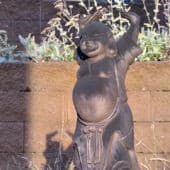In general, the eighty-four thousand collections of Buddhist teachings or the three progressive turnings of the wheel of the doctrine taught by the Buddha can all be condensed into two intentions: to put an end to all types of mental distortion with regard to the “I” or the misconception of self and thereby to acquaint ourselves with an altruistic attitude through which we take responsibility for the welfare of others.
Here you can access an in-depth commentary to Nam-kha Pel’s lojong text Mind Training Like Rays of the Sun, given by Venerable Thubten Chodron and other Sravasti Abbey monastics between 2008 and 2010.
About the author
Nam-kha Pel was a direct disciple of Lama Tsongkhapa, who lived in Tibet around the 15th century. Little is known about him except that he appears to have been the scribe for many of Tsongkhapa’s literary works and was praised by Je Rinpoche for his intelligence and faith.
About the text
Mind Training Like the Rays of the Sun is Nam-kha Pel’s commentary on The Seven-Point Thought Transformation, a fundamental mind-training text originally recorded by Geshe Chekawa.
What is distinctive about this commentary is that it combines the lojong or mind-training teachings with lamrim or graduated stages of the path teachings. Moreover, the commentary is full of quotations from classic Indian treaties and Buddhist scriptures, providing a particularly rich presentation of the path to awakening.
Overall, the text is organized according to the seven points of the original text:
1. Setting the foundation of training in preliminary practices
2. Cultivating conventional bodhicitta—the aspiration to attain enlightenment for the benefit of all beings—and ultimate bodhicitta—the wisdom realizing the ultimate nature of phenomena
3. How to transform adverse circumstances into the path to enlightenment 4. How to put thought training teachings into practice in daily life
5. How to understand when our mind has been trained
6. Mind-training commitments
7. Mind-training precepts
This text particularly emphasizes the cultivation of conventional bodhicitta by using the method of exchanging self for others, which has its roots in the works of the Indian scholar-pandits Nagarjuna and Shantideva.
Who it's for
This series of teachings provides an in-depth map of how to transform all experiences into the causes for full awakening. Moreover, it provides new and seasoned Dharma practitioners—as well as those simply interested in learning how to tame their mind—with practical guidelines on how to live a happy life now, no matter what circumstances we may meet.
Resources
Access audio and video recordings of the 77 teachings, to which full transcripts are progressively being added, here:
Never be parted from the three possessions.
You should not cease to perform virtuous physical actions, such as acts of service towards your spiritual masters and the Three Jewels, prostration and circumambulation. You should not cease to recite the refuge formula or recitations pertaining to meditational deities with your speech and in your mind you should nurture and never be parted from the awakening mind and its associated practices.
Related Series

Mind Training Like Rays of the Sun (2008-10)
An explanation of Nam-kha Pel’s commentary on the Seven-Point Mind Training by Geshe Chekawa given at Sravasti Abbey between September 20...
View Series
Nam-kha Pel’s “Mind Training Like Rays of the Sun”
How to transform all experiences into the causes for full awakening.